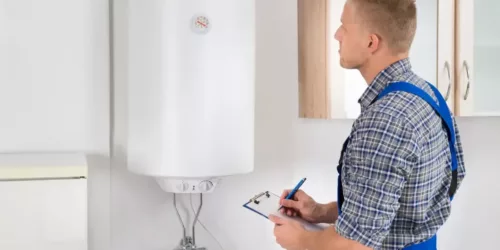Save on Heating by Keeping Your Boiler at 60°C
- How to save on heating bills at home
- Lower your boiler’s settings for peak efficiency
- Quick fixes to save money on heating
Energy prices are always susceptible to price shocks, and Ofgem sets the cap every few months. Although there is a limit on the total amount you’ll pay per unit of energy, the more you use, the more you’ll spend, so it’s important to see if you can find ways to reduce your use. This article will show you how to save on heating bills by looking at various ways in which heat is lost through the home.
While the boiler will work at its most efficient at 60°C, there are other ways in which you can make changes and save money on heating. These include making sure you have the right levels of insulation to accounting for where your thermostat is located. All of these changes will save you money, but we’ve also included quick DIY tips for how to save on heating bills.
In need of an energy efficient boiler? Use our quote comparison tool to find out how much you'd pay. It only takes a minute.

What's On This Page?
Click the links below and head straight to a specific section of the article.
Common Areas of Heat and Money Loss
In order to know how to save on heating bills in certain areas of your home, you have to understand where heat is being wasted or is escaping first. Insulation accounts for a great deal of savings, but there are other changes you can make too. Learn how to save money on heating by reading our suggestions below.
Boiler Temperature
A boiler is often set at a temperature that’s way too high, which raises your energy bills. If left unchanged, you could be paying out more than you need to. A low flow temperature is the only way your boiler will achieve its high efficiency rating, which will bring your energy bills down.
When thinking about how to save on heating bills, 60°C is the optimum temperature, for both combination and system boilers, as your hot water doesn’t need to be above this temperature. The boiler will not need to work as hard to maintain this temperature, and the water in a hot water cylinder will be heated to a high enough temperature to kill harmful bacteria, such as Legionella. Anything above this is a waste and puts further strain on your boiler, making it less efficient and costing you more.
Wall Insulation
A considerable 35-40% of heat in your home can be lost through its walls. This can be at the worse end of the scale if your walls aren’t properly insulated. To know how to save on heating bills, it depends on the construction of your walls. Homes built before 1930 will most likely have solid walls, while those built after this time will have cavity walls. Cavity walls have a free flow of air between the inner and outer wall, which allows the home to breathe. This gap, though, promotes heat loss.
Proper insulation is the way around this. Cavity walls can be filled with a variety of insulation, from polystyrene beads to blown mineral wool insulation, which is how to save on heating bills when it comes to walls. Energy Saving Trust estimates that you can save up to £155 a year by installing cavity wall insulation in a mid-terraced house.
Solid walls can also be insulated, at a higher cost than cavity walls, either on the inside or outside of the wall. Energy Saving Trust estimates that this can potentially save you £210 a year, which is really how to save on heating bills when you have solid walls. This can be up to £620 for a detached house.
Flooring Quality
Did you know that you can lose about 10% of your heat through the floor? The quality of your flooring has a big impact on how this heat escapes, and if it’s not suitably insulated, you can save a decent amount by fitting proper insulation. To understand how to save on heating bills through flooring, it’s all in the detail.
When talking about insulating the floor, it’s generally the ground floor that only really needs to be looked at. This might be solid concrete or suspended timber flooring. While solid floor insulation can be applied, a suspended timber floor requires ventilation so the joists don’t rot. Just like cavity walls, this free flow of air allows heat to escape. Thick underlay is how to save on heating bills as you can fit thick underlay to prevent any cold air seeping through from beneath the floor.
Energy Saving Trust estimates that you can save around £40 a year if you insulate underneath the floorboards. Solid floors can be fitted with rigid insulation foam either above or below the concrete in order to save money on heating.
Thermostat Position
The thermostat is an important piece of home heating kit. It has a real impact on how to save on heating bills as it reads the ambient temperature and decides if the heating has been on for long enough. Its positioning is crucial as it can only read the air temperature immediately surrounding it. If placed in an area that isn’t used or is prone to excess heat or cold, your heating system will not be warming your home properly.
A poorly placed thermostat causes incorrect temperature readings, which can lead to your heating staying on for longer than it needs to or being hotter for longer, which means your boiler works harder to maintain a false temperature and leads to higher energy bills. Ideally, to know how to save on heating bills with your thermostat, it needs to be in a room that’s lived in.
To prevent the struggle with uneven temperatures and high utility bills, avoid placing your thermostat in a cold, unused room. While the thermostat needs a free flow of air, it shouldn’t be next to a cold draught or in direct sunlight, as this will provide incorrect readings. No one lives in the hallway, so a thermostat should be placed centrally in real living conditions and temperatures. That is how to save on heating bills, just by moving your thermostat.
Windows
The windows of a home can account for 10% of heat loss. Most of this is through the pane itself, with the remainder through gaps in the frame. Secondary or double glazing is how to save on heating bills here. While secondary glazing is the cheapest alternative to triple glazing, double glazing is also a good way to reduce heat loss and improve soundproofing.
Do you know how to save on heating bills without buying new windows? If you don’t have the money to spend on new glazing, you can make use of what you have. Thick curtains are ideal for windows as they will prevent any draughts overnight. The best way to maximise the heat from the sun is to open the curtains in the morning. When closed at night, thick curtains will trap in heat and limit the amount of leaks you’ll experience.
See our article for more information on everything you need to know before installing new windows.
How to Prevent Heat Loss
Now that you’re aware of how to save on heating bills through the various ways in which heat escapes, here are some ideas of DIY solutions you can implement quickly and cheaply.
Loft Hatch
An uninsulated loft is capable of losing a quarter of a home’s heat. If insulating a loft is too much of an expense, you can simply apply insulation to the loft hatch. As long as your roof isn’t already insulated at rafter level, insulating your loft hatch is how to save on heating bills. This is a fast way to easily start seeing some savings, with a big impact.
Draught Excluders
Draughts can come from almost anywhere in a home and if your house has shifted slightly, you may experience cracks in skirting boards or in gaps in window cills or the bottom of doorways. Draught excluders are cheap and effective in how to save on heating bills. Acting as a barrier and absorbing the cold air, they prevent much of the warm air from escaping.
Draught-Proofing Strips
This is probably the easiest and most cost-effective way you can save money on heating. While you can purchase these strips almost anywhere, it’s important not to get too carried away when you’re fitting them. Some rooms are essential to having ventilation, like the kitchen and bathroom. Moisture in the air from cooking and washing needs to be able to escape in order to avoid damp and mould growth.
You can fit draught-proofing strips yourself around windows and doors to protect against any draughts coming through. This is the best self-serve way in how to save on heating bills.
How To Save Money On Heating
Now that you know how to save on heating bills, we’ve included an overview of how much you can potentially save if you implement these measures.
Related articles
View all Boiler articles
Top Tips When Buying a New Combi Boiler

Smart Boiler Installation: All You Need to Know

Smart Thermostat Guide: All You Need to Know

Boiler Systems: All You Need to Know About Domestic Boilers

What Size Boiler Do I Need for My Home?

The Complete Guide to Worcester Bosch Boilers

Hydrogen Boilers: The Ultimate Guide







